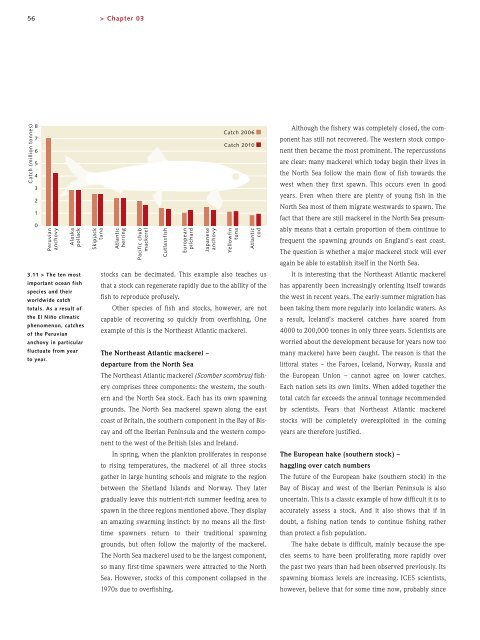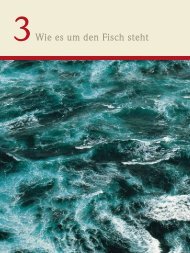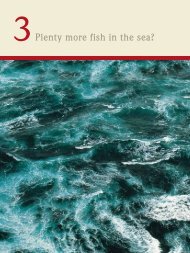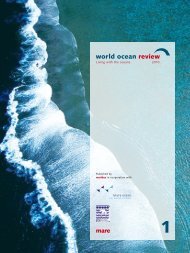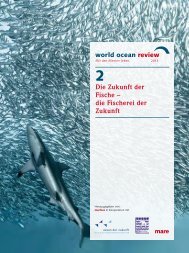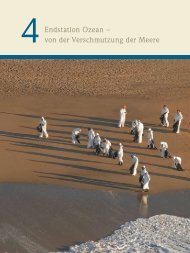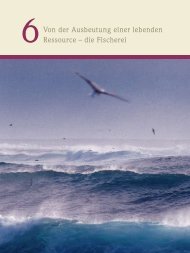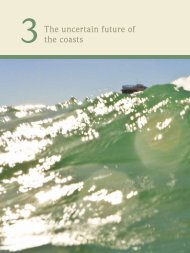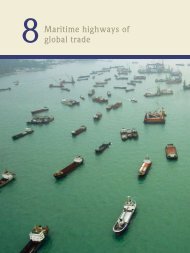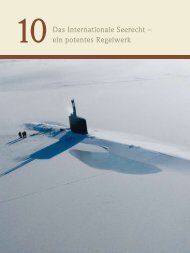Download WOR 2 PDF - World Ocean Review
Download WOR 2 PDF - World Ocean Review
Download WOR 2 PDF - World Ocean Review
You also want an ePaper? Increase the reach of your titles
YUMPU automatically turns print PDFs into web optimized ePapers that Google loves.
56> Chapter 03Catch (million tonnes)876543210PeruviananchovyAlaskapollack3.11 > The ten mostimportant ocean fishspecies and theirworldwide catchtotals. As a result ofthe El Niño climaticphenomenon, catchesof the Peruviananchovy in particularfluctuate from yearto year.SkipjacktunaAtlanticherringPacific chubmackerelCutlassfishEuropeanpilchardJapaneseanchovyCatch 2006Catch 2010YellowfintunaAtlanticcodstocks can be decimated. This example also teaches usthat a stock can regenerate rapidly due to the ability of thefish to reproduce profusely.Other species of fish and stocks, however, are notcapable of recovering so quickly from overfishing. Oneexample of this is the Northeast Atlantic mackerel.The Northeast Atlantic mackerel –departure from the North SeaThe Northeast Atlantic mackerel (Scomber scombrus) fisherycomprises three components: the western, the southernand the North Sea stock. Each has its own spawninggrounds. The North Sea mackerel spawn along the eastcoast of Britain, the southern component in the Bay of Biscayand off the Iberian Peninsula and the western componentto the west of the British Isles and Ireland.In spring, when the plankton proliferates in responseto rising temperatures, the mackerel of all three stocksgather in large hunting schools and migrate to the regionbetween the Shetland Islands and Norway. They latergradually leave this nutrient-rich summer feeding area tospawn in the three regions mentioned above. They displayan amazing swarming instinct: by no means all the firsttimespawners return to their traditional spawninggrounds, but often follow the majority of the mackerel.The North Sea mackerel used to be the largest component,so many first-time spawners were attracted to the NorthSea. However, stocks of this component collapsed in the1970s due to overfishing.Although the fishery was completely closed, the componenthas still not recovered. The western stock componentthen became the most prominent. The repercussionsare clear: many mackerel which today begin their lives inthe North Sea follow the main flow of fish towards thewest when they first spawn. This occurs even in goodyears. Even when there are plenty of young fish in theNorth Sea most of them migrate westwards to spawn. Thefact that there are still mackerel in the North Sea presumablymeans that a certain proportion of them continue tofrequent the spawning grounds on England’s east coast.The question is whether a major mackerel stock will everagain be able to establish itself in the North Sea.It is interesting that the Northeast Atlantic mackerelhas apparently been increasingly orienting itself towardsthe west in recent years. The early-summer migration hasbeen taking them more regularly into Icelandic waters. Asa result, Iceland’s mackerel catches have soared from4000 to 200,000 tonnes in only three years. Scientists areworried about the development because for years now toomany mackerel have been caught. The reason is that thelittoral states – the Faroes, Iceland, Norway, Russia andthe European Union – cannot agree on lower catches.Each nation sets its own limits. When added together thetotal catch far exceeds the annual tonnage recommendedby scientists. Fears that Northeast Atlantic mackerelstocks will be completely overexploited in the comingyears are therefore justified.The European hake (southern stock) –haggling over catch numbersThe future of the European hake (southern stock) in theBay of Biscay and west of the Iberian Peninsula is alsouncertain. This is a classic example of how difficult it is toaccurately assess a stock. And it also shows that if indoubt, a fishing nation tends to continue fishing ratherthan protect a fish population.The hake debate is difficult, mainly because the speciesseems to have been proliferating more rapidly overthe past two years than had been observed previously. Itsspawning biomass levels are increasing. ICES scientists,however, believe that for some time now, probably since


